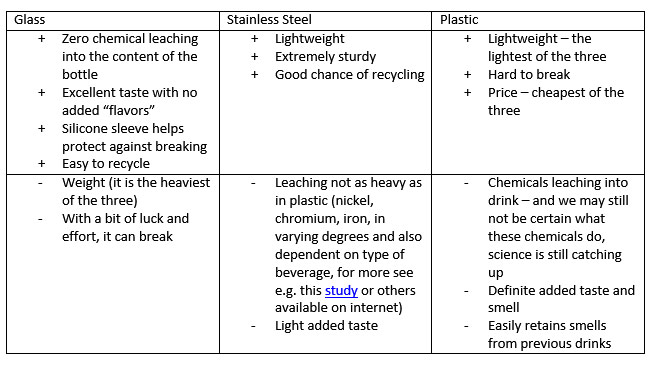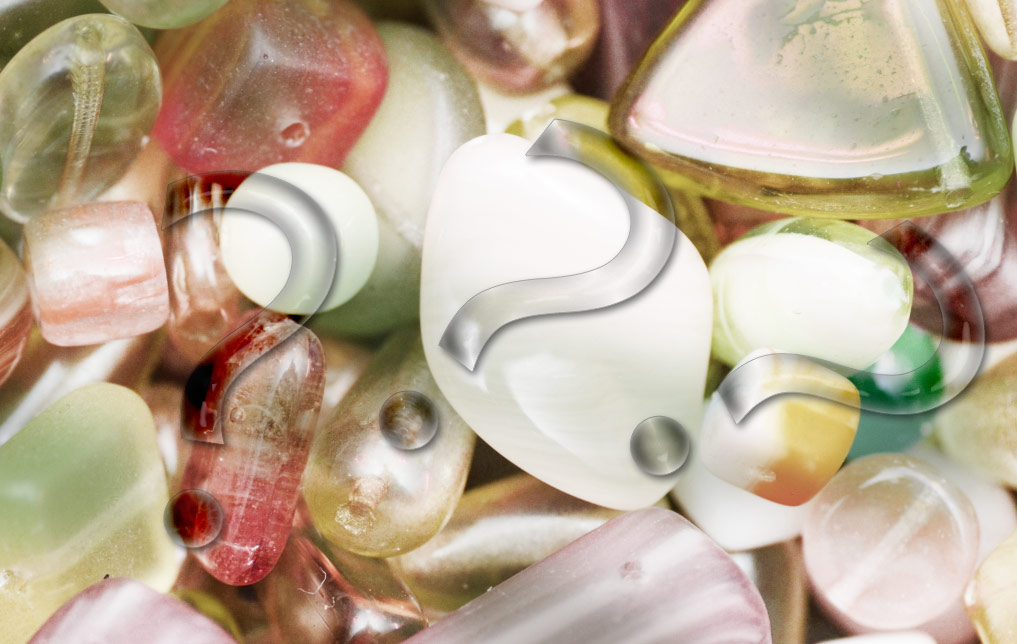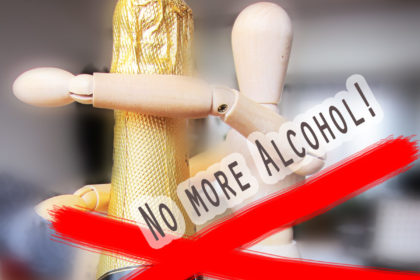What is the best material for a reusable water bottle? For us, the winner is glass, but the answer is always individual and depends on your specific circumstances of course. We’ve prepared a brief overview that will help you decide, focusing on chemical safety, weight, pros and cons and other aspects you need to weigh when deciding.

GLASS BOTTLE is ideal for you if you’re sensitive to added tastes and smells; if you are concerned about potential chemical leaching; if weight isn’t so much of an issue; if you like the design.And to break it down, short story long:
Breaking is possibly the biggest issue when you’re considering glass. However, there are many examples on the internet from actual users who have been pleasantly surprised by the sturdiness of their bottles – even a LifeFactory bottle tossed across a concrete parking lot by a child with a hissy fit survived with no problems. This is also due to the protective silicone sleeve that should never be missing.
The winning point for us was the fact that it is absolutely neutral. Do you remember the taste of Coke from a glass bottle? It was yummier, wasn’t it? That’s because glass just doesn’t leach anything into the drink. Nada.
You do need to pay attention to the material on the lid though. Below, under the section on plastic bottles, is a more thorough breakdown of safer and less safe chemicals and reasons for that, but if you’re already decided and too lazy to read the whole thing, here it is: safer options include for instance medical-grade polypropylene; you should avoid polycarbonate, silicone, acrylic, polyether sulfone (PES), Tritan (although opinions on Tritan vary) or latex.
STAINLESS STEEL: Here you can choose between a simple stainless steel bottle, or a vacuum-insulated one. The vacuum-insulated thermos is somewhat heavier – basically because there have to be two stainless steel containers with a vacuum between them which isolates the inner chamber – but if you look forward to enjoying a nice hot coffee on a commuter train or a beautifully cold drink on a scorching day, the weight is well worth it.
Stainless steel has the big benefit of extreme sturdiness – you can theoretically use it for self-defense and whack somebody over the head with it, and still enjoy your refreshing beverage afterwards. If you choose the non-insulated bottle, you will be surprised at how lightweight it is. It’s a good option if you go camping or mountaineering – you want the sturdiness because it will be banging against all the other utensils and occasionally rocks – plus we all know a rucksack makes a very good seat. Unfortunately, the bottle does give an extra taste and depending on the type of beverage you use, there may be some leaching, especially of iron, chromium or nickel (for more detailed information, you can read this study or search the internet for others).
One word of caution – make sure that you’re really buying a stainless steel bottle. Looks may deceive you and you may in fact be holding an aluminum bottle coated with plastic lining – in which case you’d better be reading the section on plastics, as that is what’s in direct contact with your water or whatever drink you are storing in your flask. Aluminum is reactive especially with acidic content and since the lining can become compromised without you even noticing (e.g. when the bottle gets dented, which happens rather easily), you might be getting not only chemicals from the lining, but also aluminum which has been linked by some studies to Alzheimer disease and other unwholesome conditions.
Again, just like with glass, check what kind of plastic has been used on the lid – safer materials include e.g. medical-grade polypropylene, you should stay away from polycarbonates and be careful with materials like silicone, Tritan (here opinions vary), polyether sulfone (PES), polystyrene or latex.
PLASTIC – sometimes, plastic just is the best choice for the given circumstances. It is still the most preferred bottle in sports where its light weight and its resistance to shocks and falls plays a very important role.
Aside from the strange smell and taste that plastic bottles often add to their content, the big, widely known problem in plastics is BPA. Several studies indicated that BPA might leach from plastic containers into the food / beverages and several alternatives were developed. Unfortunately the BPA-free label isn’t totally surefire, studies have been published indicating that although free from BPA, some of the alternative plastics release other chemicals that, just like BPA, mimic estrogenic activity (EA) in the body, thus creating problems, especially in small children. A peer reviewed study found that as much as 90% of BPA-free materials leach chemicals with estrogenic activity. These, as quoted for instance in a study by Dr. Bittner et al, would include e.g. acrylic, polystyrene (PS), polyether sulfone (PES) or Tritan, but also latex, silicone and synthetic rubbers.
A safer solution might include for instance polypropylene since these are less likely to leach – but we suggest you search for medical grade polypropylene because BHA and BHT are often used in polypropylene as conservatives and guess what? They leach chemicals with estrogenic activity. However, if plastic is the right choice for you, finding a medical-grade polypropylene bottle is easier than you might think – and they’re quite pretty.
In general, the thing that triggers the highest leaching is UV light – sunlight in other words. If you are using a plastic bottle, try to keep it away from sunlight and from overheating, for instance leaving it in the car in the summer for a longer time and then drinking the water. Incidentally, that would go also for non-reusable plastic bottles, but that is another story.




